An Objective Prototype-Based Method for Dual-Polarization Radar Clutter Identification
Abstract
:1. Introduction
2. Review of Polarimetric Signatures of Clutter Echoes
3. Radar Measurements
4. The Prototype-Based Method
4.1. Clustering of Radar Data
4.2. Automated Classification of Radar Data
5. Results and Discussion
5.1. Assessing Performance with Training Dataset
5.2. Application to Independent Test Datasets
5.3. Statistical Comparisons
6. Conclusions
Acknowledgments
Author Contributions
Conflicts of Interest
References
- Cifelli, R.; Chandrasekar, V.; Lim, S.; Kennedy, P.C.; Wang, Y.; Rutledge, S.A. A new dual-polarization radar rainfall algorithm: Application in Colorado precipitation events. J. Atmos. Ocean. Technol. 2011, 28, 352–364. [Google Scholar] [CrossRef]
- May, P.T.; Strauch, R.G. Reducing the effect of ground clutter on wind profiler velocity measurements. J. Atmos. Ocean. Technol. 1998, 15, 579–586. [Google Scholar] [CrossRef]
- Ryzhkov, A.V.; Giangrande, S.E.; Schuur, T.J. Rainfall estimation with a polarimetric prototype of WSR-88D. J. Appl. Meteor. 2005, 44, 502–515. [Google Scholar] [CrossRef]
- Zrnić, D.S.; Ryzhkov, A.V. Polarimetry for weather surveillance radars. Bull. Am. Meteorol. Soc. 1999, 80, 389–406. [Google Scholar] [CrossRef]
- Bringi, V.N.; Williams, C.R.; Thurai, M.; May, P.T. Using dual-polarized radar and dual-frequency profiler for dsd characterization: A case study from Darwin, Australia. J. Atmos. Ocean. Technol. 2009, 26, 2107–2122. [Google Scholar] [CrossRef]
- Illingworth, A.J.; Blackman, T.M. The need to represent raindrop size spectra as normalized Gamma distributions for the interpretation of polarization radar observations. J. Appl. Meteor. 2002, 41, 286–297. [Google Scholar] [CrossRef]
- Tang, Q.; Xiao, H.; Guo, C.; Feng, L. Characteristics of the raindrop size distributions and their retrieved polarimetric radar parameters in northern and southern China. Atmos. Res. 2014, 135–136, 59–75. [Google Scholar] [CrossRef]
- Zhang, G.; Vivekanandan, J.; Brandes, E.A.; Meneghini, R.; Kozu, T. The shape–slope relation in observed gamma raindrop size distributions: Statistical error or useful information? J. Atmos. Ocean. Technol. 2003, 20, 1106–1119. [Google Scholar] [CrossRef]
- Liu, H.; Chandrasekar, V. Classification of hydrometeors based on polarimetric radar measurements: Development of fuzzy logic and neuro-fuzzy systems, and in situ verification. J. Atmos. Ocean. Technol. 2000, 17, 140–164. [Google Scholar] [CrossRef]
- Park, H.S.; Ryzhkov, A.V.; Zrnić, D.S.; Kim, K.E. The hydrometeor classification algorithm for the polarimetric WSR-88D: Description and application to an MCS. Weather Forecast. 2009, 24, 730–748. [Google Scholar] [CrossRef]
- Wen, G.; Protat, A.; May, P.T.; Wang, X.; Moran, W. A cluster-based method for hydrometeor classification using polarimetric variables. Part i: Interpretation and analysis. J. Atmos. Ocean. Technol. 2015, 32, 1320–1340. [Google Scholar] [CrossRef]
- Wen, G.; Protat, A.; May, P.T.; Moran, W.; Dixon, M. A cluster-based method for hydrometeor classification using polarimetric variables. Part II: Classification. J. Atmos. Ocean. Technol. 2016, 33, 45–60. [Google Scholar] [CrossRef]
- Wen, G.; Oue, M.; Protat, A.; Verlinde, J.; Xiao, H. Ice particle type identification for shallow arctic mixed-phase clouds using X-band polarimetric radar. Atmos. Res. 2016, 182, 114–131. [Google Scholar] [CrossRef]
- Wilson, J.W.; Weckwerth, T.M.; Vivekanandan, J.; Wakimoto, R.M.; Russell, R.W. Boundary layer clear-air radar echoes: Origin of echoes and accuracy of derived winds. J. Atmos. Ocean. Technol. 1994, 11, 1184–1206. [Google Scholar] [CrossRef]
- Steiner, M.; Smith, J.A. Use of three-dimensional reflectivity structure for automated detection and removal of nonprecipitating echoes in radar data. J. Atmos. Ocean. Technol. 2002, 19, 673–686. [Google Scholar] [CrossRef]
- Tang, L.; Zhang, J.; Langston, C.; Krause, J.; Howard, K.; Lakshmanan, V. A physically based precipitation–nonprecipitation radar echo classifier using polarimetric and environmental data in a real-time national system. Weather Forecast. 2014, 29, 1106–1119. [Google Scholar] [CrossRef]
- Kessinger, C.; Ellis, S.; Andel, J.V. The Radar Echo Classifier: A Fuzzy Logic Algorithm for the WSR-88D. In Proceedings of the Third Conference on Artificial Intelligence Applications to the Environmental Science, Long Beach, CA, USA, 8–11 February 2003; pp. 1–11. [Google Scholar]
- Berenguer, M.; Sempere-Torres, D.; Corral, C.; Sánchez-Diezma, R. A fuzzy logic technique for identifying nonprecipitating echoes in radar scans. J. Atmos. Ocean. Technol. 2006, 23, 1157–1180. [Google Scholar] [CrossRef]
- Lakshmanan, V.; Karstens, C.; Krause, J.; Tang, L. Quality control of weather radar data using polarimetric variables. J. Atmos. Ocean. Technol. 2014, 31, 1234–1249. [Google Scholar] [CrossRef]
- Rennie, S.J.; Curtis, M.; Peter, J.; Seed, A.W.; Steinle, P.J.; Wen, G. Bayesian echo classification for Australian single-polarization weather radar with application to assimilation of radial velocity observations. J. Atmos. Ocean. Technol. 2015, 32, 1341–1355. [Google Scholar] [CrossRef]
- Li, Y.; Zhang, G.; Doviak, R.J. Ground clutter detection using the statistical properties of signals received with a polarimetric radar. IEEE Trans. Signal Process. 2014, 62, 597–606. [Google Scholar] [CrossRef]
- Hubbert, J.C.; Dixon, M.; Ellis, S.M.; Meymaris, G. Weather radar ground clutter. Part I: Identification, modeling, and simulation. J. Atmos. Ocean. Technol. 2009, 26, 1165–1180. [Google Scholar] [CrossRef]
- Hubbert, J.C.; Dixon, M.; Ellis, S.M. Weather radar ground clutter. Part II: Real-time identification and filtering. J. Atmos. Ocean. Technol. 2009, 26, 1181–1197. [Google Scholar] [CrossRef]
- Doviak, R.J.; Zrnić, D.S. Doppler Radar and Weather Observations, 2nd ed.; Dover Publications, Inc.: Mineola, NY, USA; 2006; p. 562. [Google Scholar]
- Peter, J.R.; Seed, A.; Steinle, P.J. Application of a Bayesian classifier of anomalous propagation to single-polarization radar reflectivity data. J. Atmos. Oceanic Technol. 2013, 30, 1985–2005. [Google Scholar] [CrossRef]
- Zrnić, D.S.; Melnikov, V.M.; Ryzhkov, A.V. Correlation coefficients between horizontally and vertically polarized returns from ground clutter. J. Atmos. Ocean. Technol. 2006, 23, 381–394. [Google Scholar] [CrossRef]
- Ryzhkov, A.V.; Zrnić, D.S. Polarimetric rainfall estimation in the presence of anomalous propagation. J. Atmos. Ocean. Technol. 1998, 15, 1320–1330. [Google Scholar] [CrossRef]
- Giuli, D.; Gherardelli, M.; Freni, A.; Seliga, T.A.; Aydin, K. Rainfall and clutter discrimination by means of dual-linear polarization radar measurements. J. Atmos. Ocean. Technol. 1991, 8, 777–789. [Google Scholar] [CrossRef]
- Ryzhkov, A.V.; Schuur, T.J.; Burgess, D.W.; Heinselman, P.L.; Giangrande, S.E.; Zrnic, D.S. The Joint Polarization Experiment: Polarimetric rainfall measurements and hydrometeor classification. Bull. Am. Meteorol. Soc. 2005, 86, 809–824. [Google Scholar] [CrossRef]
- Dixon, M.J.; Kessinger, C.J.; Hubbert, J.C. Echo Classification within the Spectral Domain to Discriminate Ground Clutter from Meteorological Targets. In Proceedings of the 86th AMS Annual Meeting, Atlanta, GA, USA, 28 January–3 February 2006. [Google Scholar]
- Ryzhkov, A.; Zhang, P.; Doviak, R.; Kessinger, C. Discrimination between Weather and Sea Clutter using Doppler and Dual-Polarization Weather Radars. In Proceedings of the 27th General Assembly of the International Union of Radio Science, Maastricht, The Netherlands, 17–24 August 2002; p. 3. [Google Scholar]
- Bachmann, S.; Zrnić, D. Spectral density of polarimetric variables separating biological scatterers in the vad display. J. Atmos. Oceanic Technol. 2007, 24, 1186–1198. [Google Scholar] [CrossRef]
- Martin, W.J.; Shapiro, A. Discrimination of bird and insect radar echoes in clear air using high-resolution radars. J. Atmos. Oceanic Technol. 2007, 24, 1215–1230. [Google Scholar] [CrossRef]
- Zaugg, S.; Saporta, G.; Van Loon, E.; Schmaljohann, H.; Liechti, F. Automatic identification of bird targets with radar via patterns produced by wing flapping. J. R. Soc. Interface 2008, 5, 1041–1053. [Google Scholar] [CrossRef] [PubMed]
- Zhang, P.; Liu, S.; Xu, Q. Identifying Doppler velocity contamination caused by migrating birds. Part I: Feature extraction and quantification. J. Atmos. Oceanic Technol. 2005, 22, 1105–1113. [Google Scholar] [CrossRef]
- Liu, S.; Xu, Q.; Zhang, P. Identifying Doppler velocity contamination caused by migrating birds. Part II: Bayes identification and probability tests. J. Atmos. Oceanic Technol. 2005, 22, 1114–1121. [Google Scholar] [CrossRef]
- Zhang, P.; Ryzhkov, A.; Zrnić, D. Observations of Insects and Birds with a Polarimetric Prototype of the WSR-88D Radar. In Proceedings of the 32d International Conference on Radar Meteorology, Albuquerque, NM, USA, 22 October 2005. [Google Scholar]
- Van Den Broeke, M.S. Polarimetric radar observations of biological scatterers in hurricanes irene (2011) and sandy (2012). J. Atmos. Ocean. Technol. 2013, 30, 2754–2767. [Google Scholar] [CrossRef]
- Melnikov, V.M.; Istok, M.J.; Westbrook, J.K. Asymmetric radar echo patterns from insects. J. Atmos. Ocean. Technol. 2015, 32, 659–674. [Google Scholar] [CrossRef]
- Keenan, T.; Wilson, J.; Lutz, J.; Glasson, K.; May, P. Rationale and Use of the CP2 Testbed in Brisbane, Australia. In Proceedings of the 33rd Conference on Radar Meteorology, Cairns, Australia, 6–10 August 2007. [Google Scholar]
- Schuur, T.; Ryzhkov, A.; Heinselman, P. Observation and Classification of Echoes with the Polarimetric WSR-88D Radar; NOAA/NSSL: Oklahoma, OK, USA, 2003; p. 46. [Google Scholar]
- Zrnić, D.S.; Ryzhkov, A.V. Observations of insects and birds with a polarimetric radar. IEEE Trans. Geosci. Remote 1998, 36, 661–668. [Google Scholar] [CrossRef]
- Runnalls, A.R. A Kullback-leibler approach to Gaussian mixture reduction. IEEE Trans. Aerosp. Electron. Syst. 2007, 43, 989–999. [Google Scholar] [CrossRef]
- Vivekanandan, J.; Ellis, S.M.; Oye, R.; Zrnić, D.S.; Ryzhkov, A.V.; Straka, J. Cloud microphysics retrieval using S-band dual-polarization radar measurements. Bull. Am. Meteorol. Soc. 1999, 80, 381–388. [Google Scholar] [CrossRef]
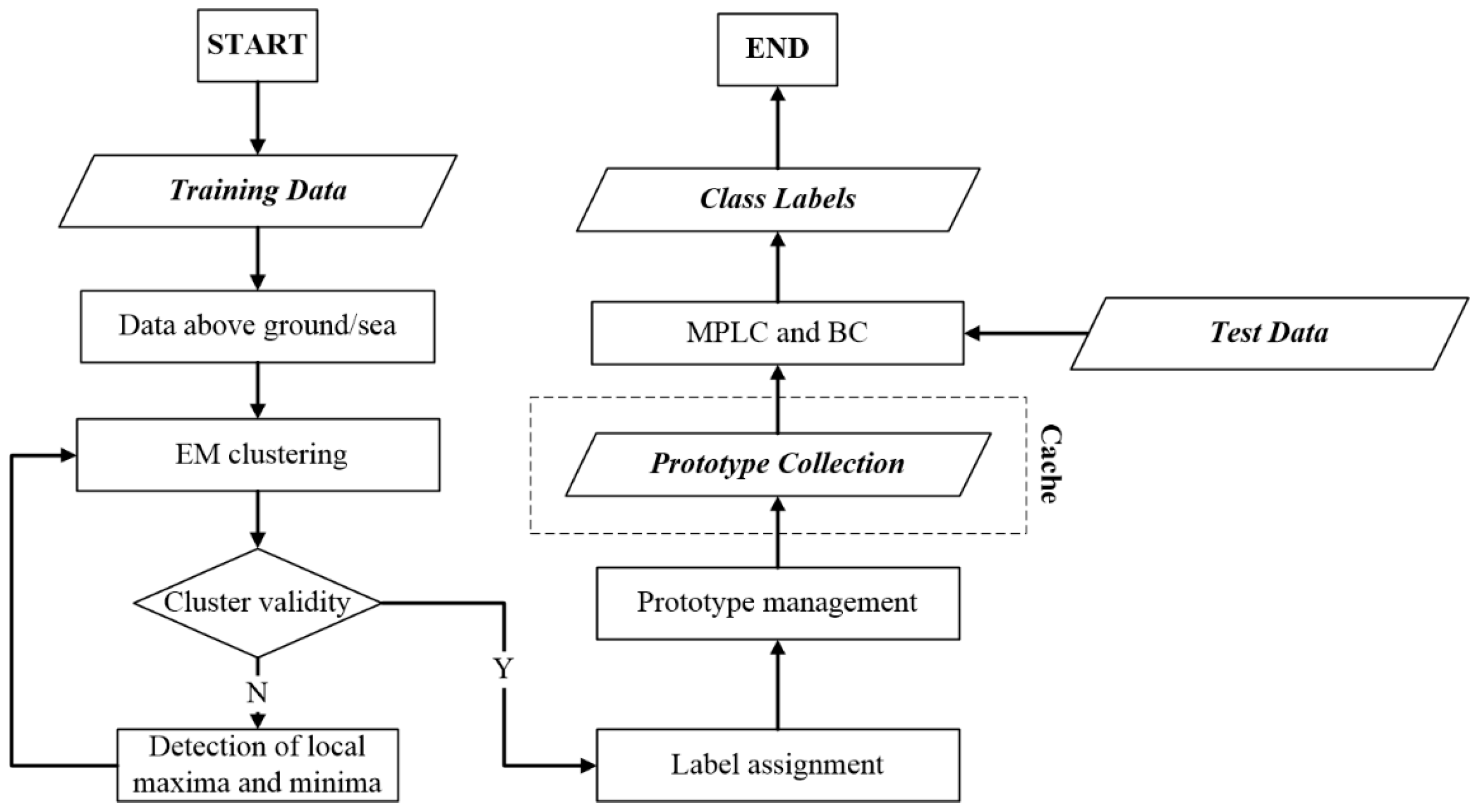
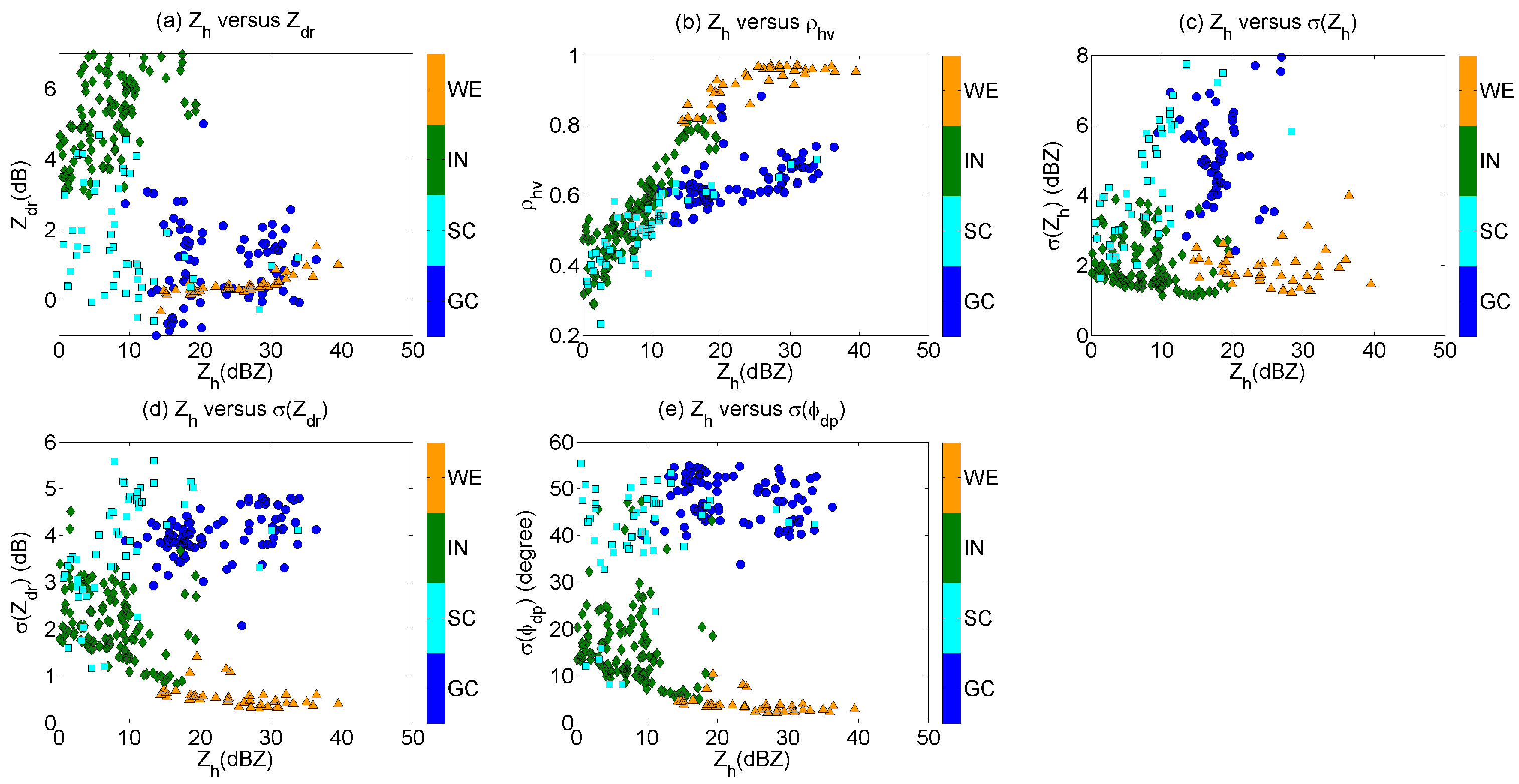


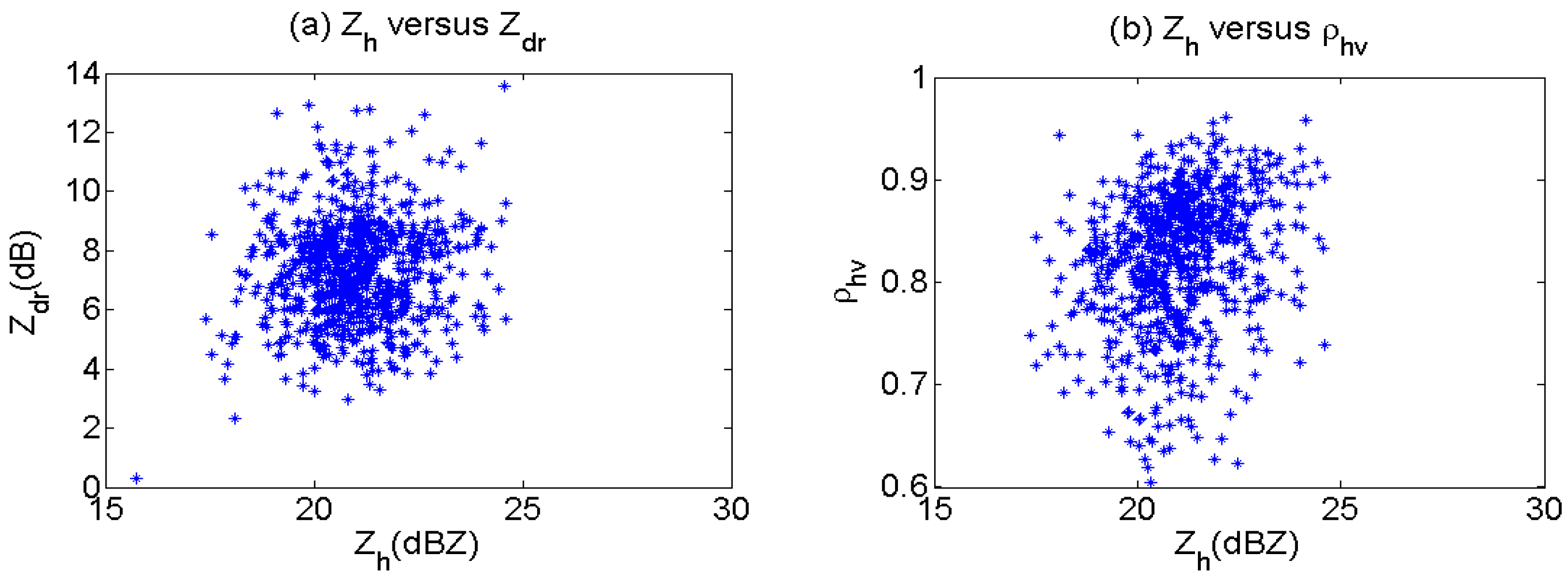
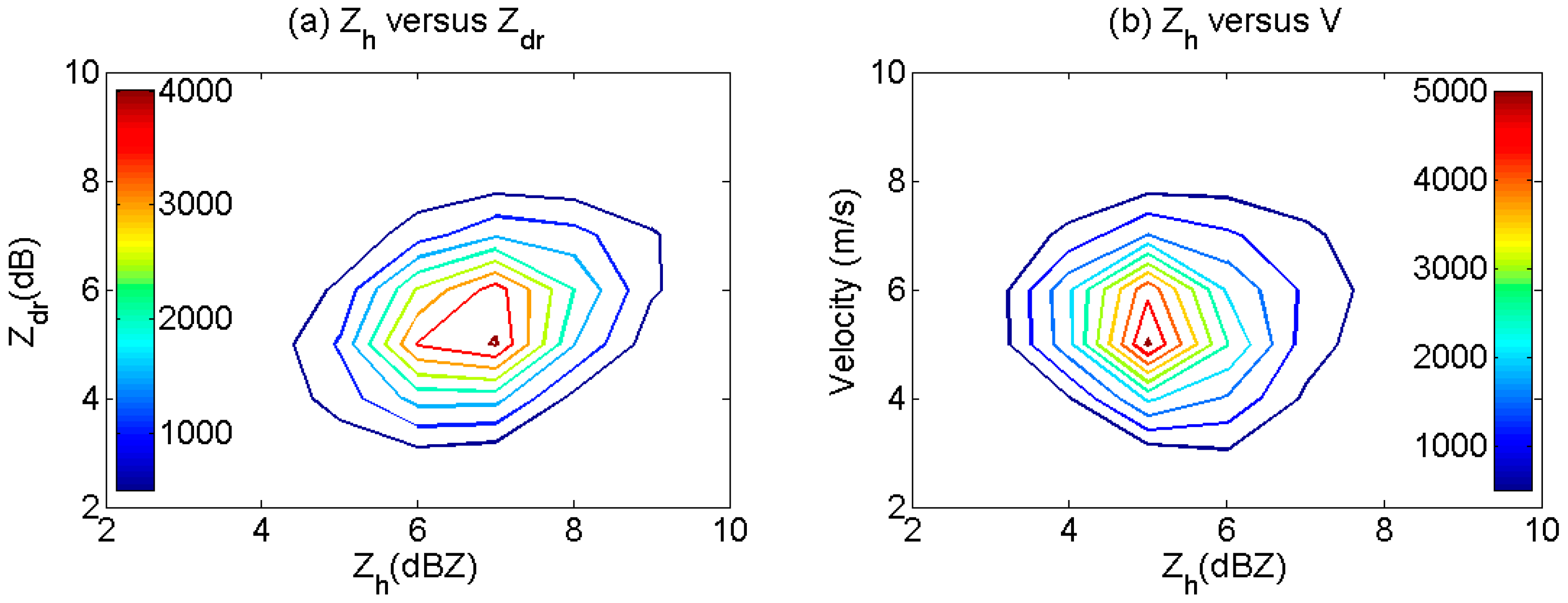
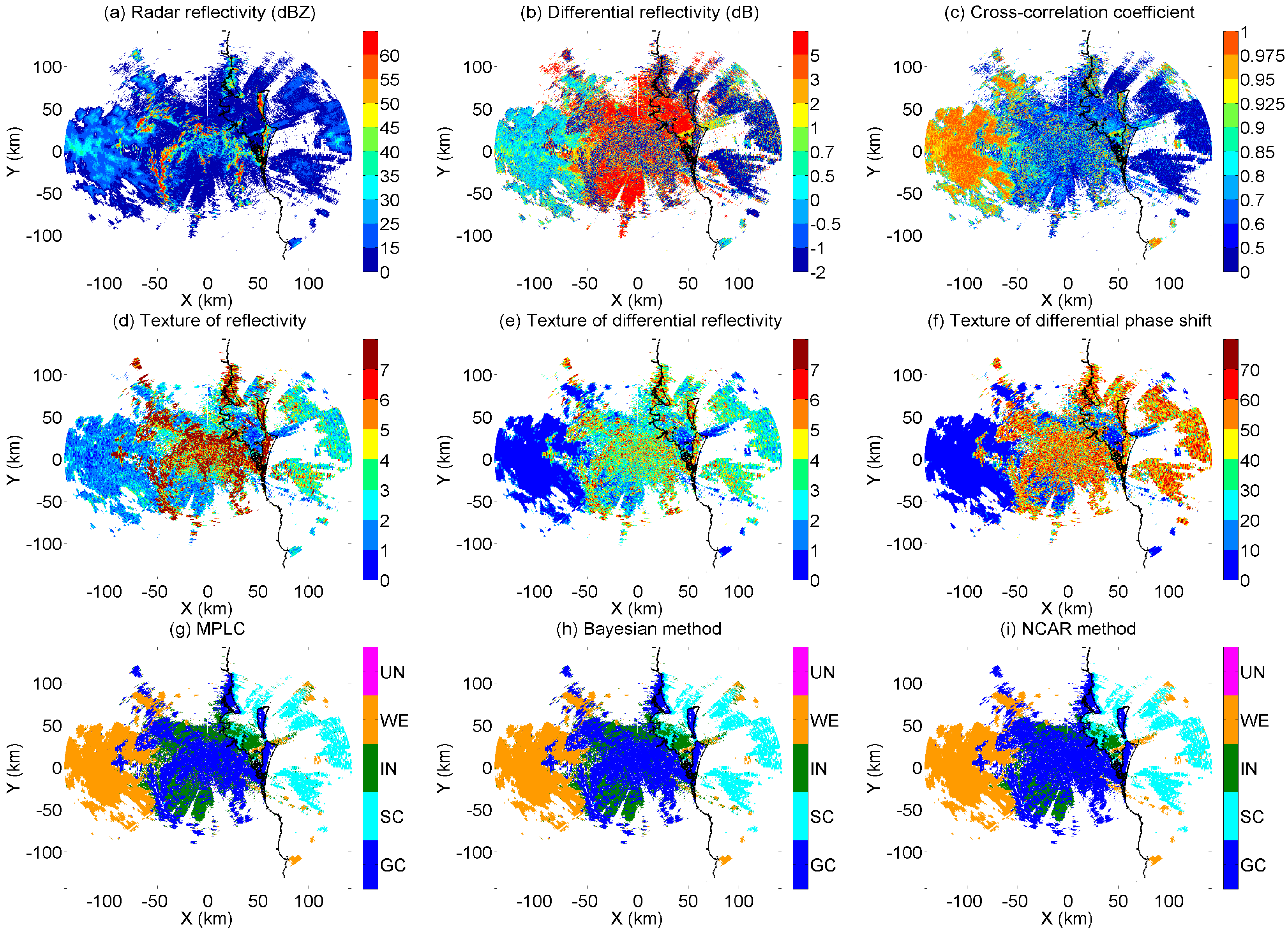
| Date (dd/mm/year) | Time (UTC) | Description |
|---|---|---|
| 6/11/2008 | 1242–1330 | Sea clutter |
| 8/11/2008 | 0612–1622 | Storms |
| 14/11/2008 | 1600–1900 | Sea clutter |
| 17/11/2008 | 0630–2024 | Storms |
| 18/11/2008 | 0636–1500 | Storms |
| 19/11/2008 | 0718–1800 | Storms |
| 2012–2218 | Sea clutter | |
| 21/11/2008 | 1330–1500 | Sea clutter |
| 28/11/2008 | 0900–1400 | Insects & light rain |
| 6/12/2008 | 0724–1048 | Convective storms |
| 7/12/2008 | 0554–0706 | Convective storms |
| 2000–0342 | Storms | |
| 15/12/2008 | 0354–0712 | Insects & storms |
| 18/12/2008 | 0912–1130 | Insects & convective storms |
| 2000–2218 | Sea clutter | |
| 19/12/2008 | 0912–1712 | Insects |
| 7/01/2009 | 0912–1600 | Insects & light rain |
| 15/01/2009 | 0918–1800 | Insects |
| 16/01/2009 | 0912–2348 | Insects, light rain, & sea clutter |
| 17/01/2009 | 0912–1700 | Insects & light rain |
| 22/01/2009 | 0912–1330 | Insects & storms |
| 23/01/2009 | 0918–1836 | Insects, sea clutter, & storms |
| Date (dd/mm/year) | Time (UTC) | Description |
|---|---|---|
| 6/11/2008 | 0900–1212 | Insects |
| 1436–1554 | Sea clutter | |
| 8/11/2008 | 1828–1922 | Sea clutter & light rain |
| 20/11/2008 | 0200–0230 | Insects |
| 0630–1042 | Convective storms | |
| 21/11/2008 | 1800–1830 | Sea clutter |
| 24/01/2009 | 0912–1200 | Convective storms & insects |
| 1912–0230 | Convective storms & insects | |
| 25/01/2009 | 0912–1730 | Storms & insects |
| 31/01/2009 | 1500–1900 | Light rain, insects, & sea clutter |
| 2/02/2009 | 0912–1042 | Storms & insects |
| 8/02/2009 | 0912–1912 | Insects |
| 10/02/2009 | 0900–1500 | Storms & insects |
| 11/02/2009 | 0906–1824 | Storms & insects |
| 12/02/2009 | 0912–1454 | Storms & insects |
| 13/02/2009 | 0118–0224 | Storms |
| 0912–1112 | Storms & insects | |
| 14/02/2009 | 0912–1500 | Storms & insects |
| Echo Types | Zh (dBZ) | Zdr (dB) | (dBZ) | (dB) | (deg) | |
|---|---|---|---|---|---|---|
| GC | variable | −3~5 | <0.9 | >2 | >3 | >30 |
| SC | variable | −3~5 | <0.7 | >2 | >3 | >30 |
| IN | <30 | 3~8 | 0.3~0.8 | 1~5 | 2~5 | 10~30 |
| WE | >5 | variable | >0.8 | <4 | <3 | <20 |
| NCAR | MPLC | ||||||||||
| MPLC | GC | SC | IN | WE | NCAR | GC | SC | IN | WE | ||
| GC | 93% | 0 | 3% | 4% | GC | 79% | 0 | 20% | 1% | ||
| SC | 0 | 64% | 1% | 35% | SC | 0 | 64% | 34% | 2% | ||
| IN | 46% | 1% | 47% | 6% | IN | 9% | 0 | 90% | 1% | ||
| WE | 1% | 0 | 0 | 99% | WE | 7% | 1% | 5% | 87% | ||
| NCAR | BC | ||||||||||
| BC | GC | SC | IN | WE | NCAR | GC | SC | IN | WE | ||
| GC | 92% | 0 | 3% | 5% | GC | 86% | 0 | 14% | 0 | ||
| SC | 0 | 63% | 2% | 35% | SC | 0 | 72% | 27% | 1% | ||
| IN | 37% | 1% | 54% | 8% | IN | 13% | 0 | 86% | 0 | ||
| WE | 1% | 0 | 0 | 99% | WE | 8% | 1% | 5% | 86% | ||
| BC | MPLC | ||||||||||
| MPLC | GC | SC | IN | WE | BC | GC | SC | IN | WE | ||
| GC | 100% | 0 | 0 | 0 | GC | 90% | 0 | 9% | 1% | ||
| SC | 0 | 99% | 1% | 0 | SC | 0 | 88% | 11% | 1% | ||
| IN | 20% | 0 | 80% | 0 | IN | 1% | 0 | 97% | 2% | ||
| WE | 0 | 0 | 1% | 99% | WE | 0 | 0 | 0 | 100% | ||
| MPLC Versus NCAR | NCAR Versus MPLC | ||||||||||||
| TS | B | FAR | H | F | TS | B | FAR | H | F | ||||
| GC | 0.74 | 43 | 0.84 | 0.07 | 0.78 | 0.08 | GC | 0.74 | 43 | 1.19 | 0.22 | 0.93 | 0.23 |
| SC | 0.46 | 491 | 0.99 | 0.37 | 0.62 | 0.00 | SC | 0.46 | 491 | 1.01 | 0.38 | 0.63 | 0.00 |
| IN | 0.45 | 48 | 1.91 | 0.53 | 0.90 | 0.15 | IN | 0.45 | 48 | 0.53 | 0.11 | 0.47 | 0.02 |
| WE | 0.85 | 1025 | 0.88 | 0.02 | 0.87 | 0.01 | WE | 0.85 | 1025 | 1.14 | 0.14 | 0.98 | 0.05 |
| BC Versus NCAR | NCAR Versus BC | ||||||||||||
| TS | B | FAR | H | F | TS | B | FAR | H | F | ||||
| GC | 0.80 | 56 | 0.93 | 0.08 | 0.86 | 0.10 | GC | 0.80 | 56 | 1.07 | 0.14 | 0.92 | 0.17 |
| SC | 0.50 | 642 | 1.14 | 0.37 | 0.72 | 0.00 | SC | 0.50 | 642 | 0.88 | 0.28 | 0.63 | 0.00 |
| IN | 0.50 | 50 | 1.59 | 0.46 | 0.86 | 0.11 | IN | 0.50 | 50 | 0.63 | 0.14 | 0.54 | 0.02 |
| WE | 0.84 | 1241 | 0.86 | 0.01 | 0.85 | 0.01 | WE | 0.84 | 1240 | 1.16 | 0.15 | 0.99 | 0.06 |
| MPLC Versus BC | MPLC Versus BC | ||||||||||||
| TS | B | FAR | H | F | TS | B | FAR | H | F | ||||
| GC | 0.89 | 2528 | 0.90 | 0.00 | 0.90 | 0.00 | GC | 0.89 | 2528 | 1.11 | 0.10 | 1.00 | 0.10 |
| SC | 0.86 | 51192 | 0.88 | 0.01 | 0.87 | 0.00 | SC | 0.86 | 51191 | 1.14 | 0.13 | 0.99 | 0.00 |
| IN | 0.77 | 344 | 1.20 | 0.20 | 0.96 | 0.06 | IN | 0.77 | 345 | 0.83 | 0.04 | 0.80 | 0.01 |
| WE | 0.98 | 124165 | 1.02 | 0.02 | 1.00 | 0.01 | WE | 0.98 | 124165 | 0.98 | 0.00 | 0.98 | 0.00 |
© 2017 by the authors. Licensee MDPI, Basel, Switzerland. This article is an open access article distributed under the terms and conditions of the Creative Commons Attribution (CC BY) license (http://creativecommons.org/licenses/by/4.0/).
Share and Cite
Wen, G.; Protat, A.; Xiao, H. An Objective Prototype-Based Method for Dual-Polarization Radar Clutter Identification. Atmosphere 2017, 8, 72. https://doi.org/10.3390/atmos8040072
Wen G, Protat A, Xiao H. An Objective Prototype-Based Method for Dual-Polarization Radar Clutter Identification. Atmosphere. 2017; 8(4):72. https://doi.org/10.3390/atmos8040072
Chicago/Turabian StyleWen, Guang, Alain Protat, and Hui Xiao. 2017. "An Objective Prototype-Based Method for Dual-Polarization Radar Clutter Identification" Atmosphere 8, no. 4: 72. https://doi.org/10.3390/atmos8040072





